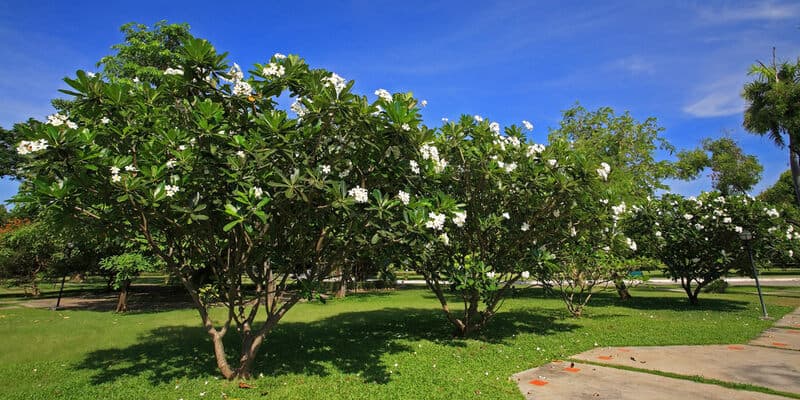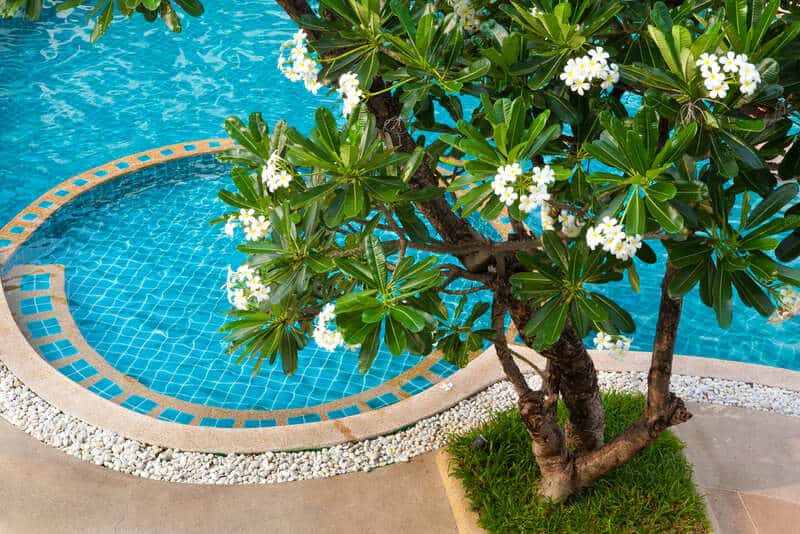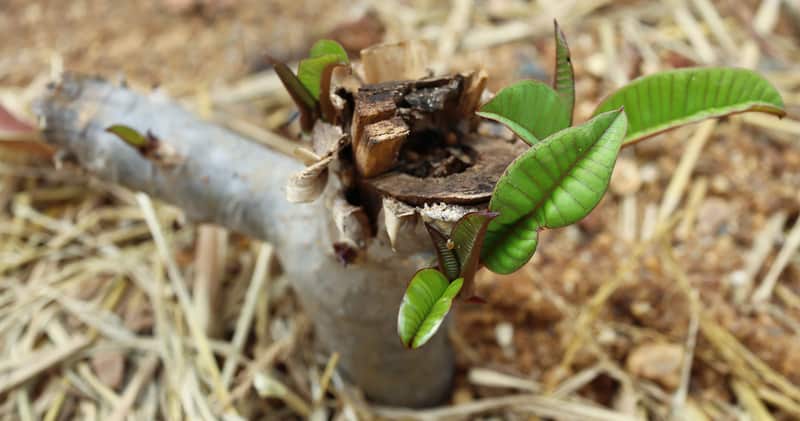When you think of frangipanis, one word comes to mind: exotic. (Also ‘hula’. Right?)
Frangipanis are ever the social butterfly of flowering trees, traveling different regions of the globe and finding a home just about anywhere, being so adaptable and all. They’re comfortable – and will take root – wherever you plant them. From old churches and Buddhist temples in Southeast Asia, to gardens in Italy, Venezuela, Mexico, and Hawaii, your frangipani tree can’t help but steal the limelight.
Frangipani flowers being so easily recognisable does wonders for their popularity in Australian backyards. They have colours FOR DAYS, and a strong fragrance to boot. Remember to thank that pink frangipani garnish when your drinking-from-a-coconut-at-the-beach photo hits 1,000 likes.
Get to know your tree
The frangipani is a flowering tree with dark green foliage and fragrant blossoms that come in clusters. You may know frangipani as kalachuchi or temple flower, depending on your location.
Here’s one more thing you’ll want to remember about them: they grow fast and they flower a lot.
You’ll be thrilled to know that these trees bloom from December through April. Some varieties have vibrant pink or red blossoms, while others are stark white with a Crayola yellow centre.
If that’s not fascinating enough, you’ll see frangipani seed pods appear after the flowers have been pollinated. These pods turn from green to black during early spring, when they become fully ripe.
Because frangipanis are deciduous, the leaves change their appearance over the course of the seasons. The bark’s scaly texture can be attributed to the marks left by the leaves when they fall off during winter.
A frangipani tree can grow to a height of 6m with a width of 5m. Dwarf varieties can reach a height of 3.6m. It’s still quite small compared to other flowering trees, though. If you’re wondering what flowering tree to put in that empty spot in your garden, the frangipani is a good match for you. Its well-contained root system and hardy countenance make maintenance a breeze for you.
Don’t let the whimsical names and candy colours fool you, though. Attractive and sturdy as the frangipani is, its sap is poisonous to humans and animals. Extra care should be taken when pruning or cutting any part of the tree, especially when there are kids and pets running around.
Frangipani tree varieties
There are more than 500 varieties of frangipanis, and their flowers all share that trademark perfume (and names which range from wholesome to controversial).
The majority of the common species are Plumeria rubra (also called the red frangipani or common frangipani), with the others being Plumeria pudica, Plumeria stenopetala, and Plumeria obtusa.
Popular frangipani varieties
- Aztec Gold (Plumeria rubra)
- Bridal Bouquet (Plumeria pudica)
- Barbados Show Girl (Plumeria rubra)
- B 052 (Plumeria rubra)
- Candy Stripe (Plumeria rubra)
- Celadine (Plumeria rubra)
- Confetti (Plumeria rubra)
- Daisy Wilcox (Plumeria rubra)
- Duvauchelle Special (Plumeria rubra)
- Elizabeth Thornton (Plumeria rubra)
- Fruit Salad (Plumeria rubra)
- Intense Rainbow (Plumeria rubra)
- Kaneohe Sunburst (Plumeria rubra)
- Lucky Star (Plumeria rubra)
- Makaha Sunn (Plumeria rubra)
- Mele Pa Bowman (Plumeria rubra x obtusa)
- Narrow Petal (Plumeria stenopetala)
- Penang Peach (Plumeria rubra)
- Riviera Rainbow (Plumeria rubra)
- Singapore Graveyard Flower (Plumeria obtusa)
- Thailand Red (Plumeria rubra)
- Toba’s Fire (Plumeria rubra)
- Vera Cruz Rose (Plumeria rubra)
- Vishanu Gold (Plumeria rubra)
- Dwarf Pink Singapore (Plumeria obtusa)
- Dwarf Watermelon (Plumeria rubra)
Australian frangipanis
Quite a long list there, but let’s focus on the fruit salad frangipani. This gorgeous (very Australian) flower comes in shades of apricot, pink, and red. It’s aptly nicknamed Aussie sunset, Giant Aussie orange, and West Oz Apricot.
The Australian native frangipani tree, Hymenosporum flavum, deserves its own section here. While it shares the same name with the frangipani, they are different genus-wise. One thing they do have in common is having strongly perfumed flowers.
The native frangipani tree also has a couple of advantages over the non-native frangipanis. Unlike the deciduous frangipani varieties, this evergreen frangipani doesn’t lose its leaves during winter. Its nectar is also a food source for many garden animals. If you’re thinking of a way to attract more butterflies, birds, and bees into your garden, this would be it.
How to grow frangipani
Where to plant frangipanis
Take advantage of the frangipani’s shade and perfumed scent by planting it in a spot where it’s easily accessible to you. A planting site near the front gate, near a window or beside the pool would make the most out of the frangipani’s foliage and flowers. Pick a sunny spot with sandy soil while you’re at it, as frangipani trees thrive well under these conditions.
How to grow a frangipani tree from a branch
The frangipani flower and the beach are a match made in summer heaven. Think of your ultimate tropical vacation when growing frangipani: plenty of sun, sandy soil, salty air, and absolutely no frost at all.
To plant your tree from a branch, place your cutting in coarse sand, then water once a week to allow the roots to grow. Transfer to your chosen planting site. Late spring to summer is the best time to start propagating your tree from a cutting.
Step 1
To have frangipani cuttings of your own, cut off a branch or two from an established tree. Remove the flowers and leaves on the lower end of the cutting and allow the base to dry out.
Step 2
Plant the cutting in coarse sand and water once a week until roots start to grow out.
Step 3
Transfer the frangipani to a pot with good quality potting mix or directly in the ground. Make sure that your soil is fast-draining and there’s plenty of sunlight where the planting site is.
How to grow frangipani in pots
Are you ready to turn your balcony into a spa-like oasis? With a few garden lights and some potted frangipanis, you can create the outdoor space of your dreams.
Growing frangipanis in pots is quick and easy. Wide, shallow pots with holes are your best bet when choosing a container for your frangipani. Fill the pot with a high-quality fast-draining potting mix, such as cactus mix. Choose a potting medium with pumice, poultry grit, or perlite added. Place your frangipani cutting in the pot and there you have it. Completely fuss-free.
What to plant under your frangipani tree
How to not get too thrilled about this topic, is the question. We’re talking about low plants here whose leaves and flowers can contrast well with the frangipani.
You also have to take into account where you’re located. The garden soil type and weather conditions in your area are important factors to consider, after all. As such, look for companion plants that like dry, shady areas.
Beach-worthy plants
If your frangipani is lucky enough to be living beside the beach (most plants shy away from coastal conditions, though!), African daisies, felt plants, blue chalksticks, and cushion bush are your plant’s best companions. They provide a good contrast of colour and height while thriving well in sandy soil.
Plants with structural foliage
Succulents, cycads, giant taro, and elephant ears are amazing plants to consider when landscaping around a frangipani. The shape, colour, and texture of these plants’ foliage are striking against the dark green leaves and colourful flowers of your frangipanis. When landscaped with your frangipani, they give your garden that flair and drama any stylish garden owner would be proud to flaunt.
Plants for good root coverage
To hide the surface roots of your frangipani, plant philodendrons at the base of your tree. They’ll cover the roots of your frangipani and give your garden a fuller, leafier look. Choose hardier and less expensive philodendron varieties for this purpose. The pink princess philodendron may not be your best option here, matching as it is to your pink frangipani. You’d want a low-maintenance plant for simple root coverage.
For a pop of magenta, add a layer of cordylines between your frangipani and philodendron. Cordylines love semi-shaded areas and are easy to maintain, too.
Frangipani tree disease
Tree rot
If frangipanis are impervious to the elements and virtually indestructible against pests and insects, can they ever get sick? Surprisingly, the answer is yes. This toughie can get hit by something less obvious – fungus.
Fungi can cause root, branch, and tip rot in your frangipanis. Squeeze your tree’s stems and check if they’re feeling soft. A healthy tree branch will feel firm compared to an infected tree, which will be spongy to the touch.
Treatment
To treat tree rot, reduce or avoid watering altogether. You can also spray with an eco fungicide to kill the fungi that’s causing the rot. For more severe cases, prune off the whole branch to prevent the infection from spreading to other parts of the tree.
How to prune a frangipani tree
Pruning frangipani has its benefits. For one, pruning manages the size and shape of your tree. The other more important reason goes beyond aesthetics. Pruning is an effective way to prevent fungi from seeping into your tree and causing root, branch, and tip rot.
The best time to prune your tree is in the winter or early spring to avoid cutting off the blooms. Use sharp pruning tools that are sterile when cutting off sick or dead branches.
Step 1
Prune off sick or dead branches any time of the year to boost your tree’s growth and prevent any infection from spreading to healthier parts of the tree.
Step 2
Trim off 15-20% of the canopy to allow air and sunlight to circulate into the tree. Opening up your tree helps it photosynthesise and prevents tree rot in the process.
If you’re unsure which branches need to be pruned or trimmed off, it’s best not to risk your tree’s wellbeing. You can request for professional pruning and trimming services from your local gardeners when you see that it’s time to thin down your tree or do some preventive maintenance on the branches.
Frangipani tree care
Frangipanis are pretty as a picture and tough as nails. They can withstand extreme heat, drought, and even pest infestation. Once established, your new plant won’t need that much watering and fertilising.
When caring for your flowering tree is this easy, you can have your own piece of tropical paradise right in your own backyard.









